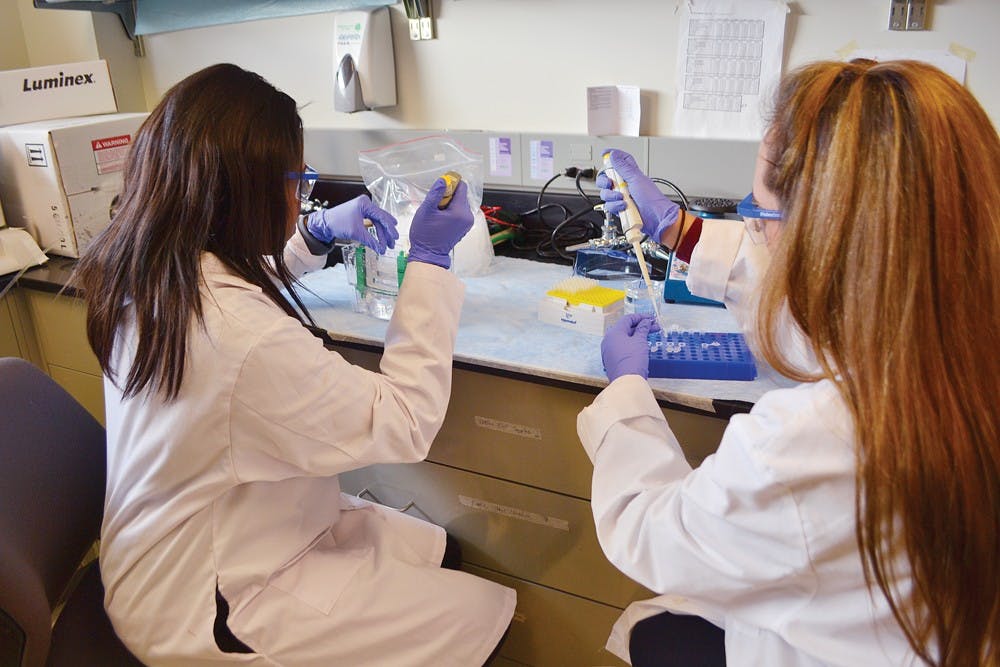Editorial: Gender gap in STEM stalling progression

The introduction of Title XI over 40 years ago meant the equalization of education programs for males and females. With that being said, men still out number women in nearly every science and engineering major. How far have we as a society have we come? Not far enough, at least with programs implementing science, technology, engineering and mathematics.
The gender gap has shown a massive under representation of women in STEM fields.
The U.S. Department of Commerce found only one in seven engineers are female. To make matters worse women have seen no sufficient employment growth in STEM jobs in fourteen years. Only 27 percent of computer science jobs are held by women, while less than 20 percent of bachelor degrees in computer science go to women.
This is shocking since 60 percent of bachelors degrees are held by women.
The gender-gap is in existence due to prolonged discouragement and preexisting bias about females in STEM fields. This is experienced as early as grade school for girls.
Young girls are not always encouraged to pursue science and math in grade school, and when they do show interest it is treated as though it's a miracle. When a girl does well in any STEM field she is said to be a hard worker, but when a boy does well it is treated as though it is a natural tendency for him. The consequences of exposure to bias this early on is detrimental to the further pursuit of STEM fields for girls.
More than often girls do not feel confident enough to continue their pursuit with science and math because society deems it a boys field of work. This is subtle and is intensified when young girls can't picture themselves in these fields of study because they have no real role models in STEM fields.
Pop culture depicts images of women pursuing jobs as doctors, lawyers and teachers but never a computer or biochemical engineers. The image of engineers is shown through a white male who is often deemed a geek.
Girls continue to take and perform well in science and math classes throughout middle school and high school.The transition from high school to college shows the impact of underlying bias.
Only 19 percent of first year females said they wanted to pursue STEM based curriculum in comparison of 35 percent of males who also showed interest. The subtle discouragement experienced in their early years influences many females when deciding a college major.
The messages that girls received in the past, along with their experiences, leads them to develop a lower interest in STEM despite their strong skills in the field.
Even after pursuing a job in the STEM fields, nearly one in five women leave the work force even with degree in STEM. This is due to underlying prejudice and bias existing in the work force for women. The barriers are in an endless loop, that only a societal change can break.
The gender gap in STEM field is detrimental to the U.S. in the future. Demand for skilled workers in STEM is linked closely with global competitiveness. This only furthers the challenges of globalization, there is a perpetual need for STEM jobs to be filled.
The encouragement of women to participate in the STEM field is crucial because men will not be able to fill the need for STEM based jobs on their own. Lack of gender and ethnic diversity in students pursuing STEM is negatively affecting the progression of America. This a new information-based and highly technological society, the STEM field cannot meet its need if this issue is prolonged.
Actively pursuing the recruitment of female students in STEM departments is a high-priority. This can be done through outreach to graduating high school students. Also, inviting undeclared and transfer students to events based around the encouragement of women pursuing STEM jobs.
Women tend to hold themselves to a higher standard when compared to men, this stems from a belief that they have to be exceptional in order to succeed as a female in STEM fields. By encouraging women to positively assess their abilities in a subject, they are more likely to continue the pursuit of more classes in that field. This would extinguish their worries of having to exceed males who are among their peers.
Most importantly it is time to drain any underlying bias and stereotypes about women in the STEM fields. Research shows that stereotypes about female abilities in STEM can have measurable impacts on their performance. This is understood as the stereotype threat.
Institutions must create learning environments that are free of negative stereotypes. In order to reach this goal, they must develop an understanding of how bias works at a personal level.
The gender gap in the STEM fields proves to be an obstacle, but it isn't unimaginable or impossible. Through the dismantling of outdated beliefs and stereotypes, the goal is closer than it may seem. If encouragement and reassurance are implemented early on with young girls, the future be as bright as this technological society deems it.







